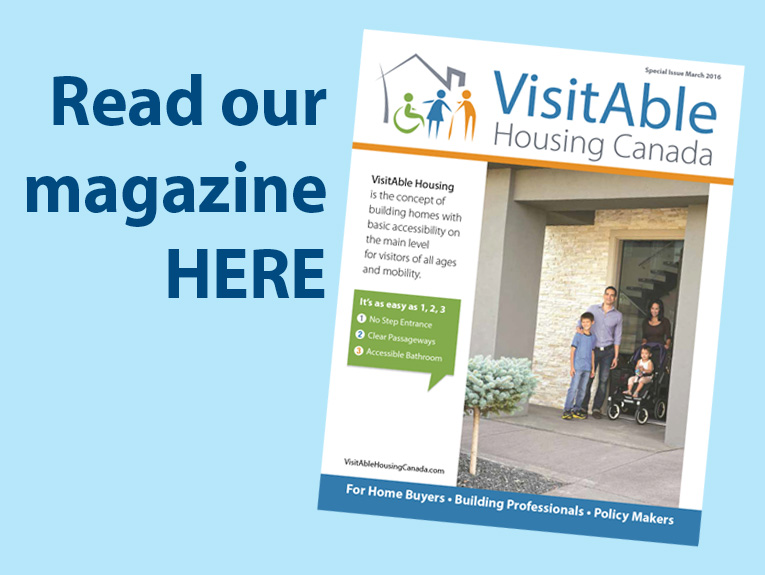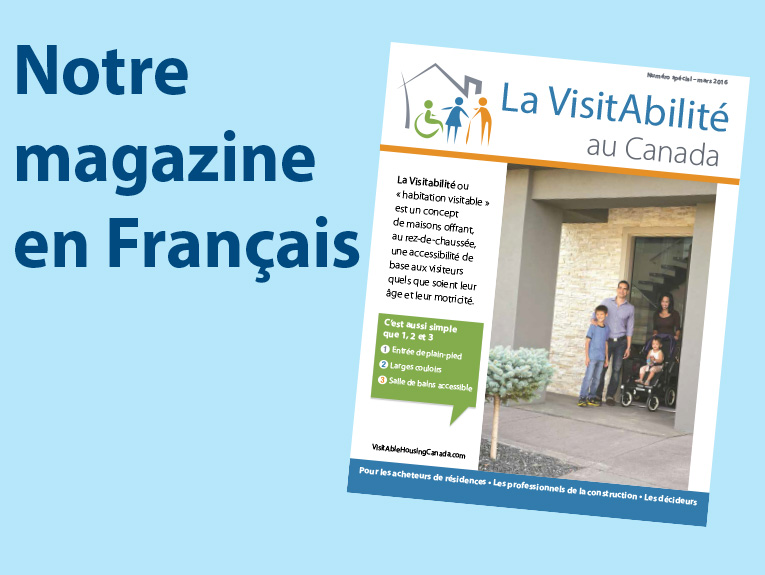The Ottawa VisitAbility Task Force has developed a VisitAble Housing Standards document, which establishes basic accessibility requirements for the design and construction of newly built dwellings, by providing reasonable criteria for VisitAbility. To access the document, please click on the following link: Ottawa Task Force VisitAble Housing Standards
Other key activities that the Ottawa VisitAbility Task Force is working on include:
- Introducing the concept of VisitAble Housing in publication opportunities available by the City of Ottawa (e.g., website, information material, events).
- Increasing VisitAble Housing in social housing projects by the City.
- Hosting a design charrette focusing on VisitAble Housing.
- Disseminating information about VisitAble Housing via websites, newsletters, and other publications of organizations and associations within task force members’ networks.
- Including VisitAble Housing in housing projects that task force members are involved.
- Developing a design of a VisitAble bungalow with a walk-out basement.
- Promoting VisitAble Housing to be included in provincial policies, such as the Ontario Building Code and the Accessibility for Ontarians with Disabilities Act (AODA).
- Making presentations on VisitAble Housing for stakeholder groups, including professionals in the housing industry, older adults, and media.
The Task Force members are:
Roger P Gervais
Coordinator, Ottawa VisitAbility Task Force
613-614-6950 or 613-821-7761
gervais.roger.p@gmail.com
Catherine Styles
613-299-7855
Catherinestyles@rogers.com
Saide Sayah
Program Manager, City of Ottawa, Affordable Housing Unit
613-580-2424, ext 43083
saide.sayah@ottawa.ca
Wayne Styles
Owner, Styles Design Build
613-299-8950 or 613-826-0463
wayne@stylesdesignbuild.com
Steve Sicard
Keller Williams Solid Rock Realty
613-853-5807 or 613-733-3434
steve@stevesicard.ca
Ottawa VisitAbility Task Force
Items of interest for our task force:
- Canada is a member of the United Nations Convention on the Rights of Persons with Disabilities since 2010, which includes accessibility of housing in Article 9, yet our National Building Code continues to exempt houses from barrier-free design requirements in section 3.8.1.1. VisitAbility is a cost-effective solution to ensure more inclusive housing. Research has proven that it is easily implemented into new construction when planned properly. Our aging population and individuals who are already facing mobility challenges desperately need more barrier-free housing stock than currently exists. VisitAbility needs to replace our existing construction techniques because current practices create barriers instead of removing them. http://www.un.org/disabilities/default.asp?id=269
- Here in Ontario, our province has a goal of being fully accessible by January 1, 2025 according to the Accessibility for Ontarians with Disabilities Act. Unfortunately, houses continue to be exempt from barrier-free design requirements in section 3.8.1.1 (similar language to the National Building Code). The AODA concerns itself mainly with accessibility of public spaces in their Design of Public Spaces standard.One encouraging section of the Ontario Building Code is section 3.8.2.1(4): this is the only part of the Barrier Free Design section of the Code that requires barrier-free design inside a dwelling. This section has been in force since 2006 and requires a barrier-free path of travel for 10% of units in residential buildings taller than three storeys or larger than 600m2. These requirements are expanding on January 1, 2015 to 15% of units, with additional features required. http://www.mah.gov.on.ca/Page10547.aspx
- In Ottawa, the City of Ottawa’s Affordable Housing Department has been investing in barrier-free and VisitAble design in 10 to 12% of new projects. There are a number of projects involved, as seen on this Dropbox document: https://www.dropbox.com/s/o52xvt6k9e7fqtw/R%20Ottawa%20Housing%20Services%20Dec%203rd%202013.pdf
- Generally speaking, barrier-free housing stock is limited to the following areas in Ontario:
- Cooperative Housing has been offering some barrier-free units for decades.
- Affordable Housing does have some barrier-free stock but research is required to identify each municipality’s availability. Ottawa appears to be a leader at this time.
- Since 2006, 10% of units are required to have a barrier-free path of travel in residential buildings taller than three storeys or larger than 600 square metres.
- Habitat for Humanity does have some barrier-free projects but are limited at this time.
- There are a limited number of custom built homes with barrier-free design features.
- Some group homes are barrier-free.



